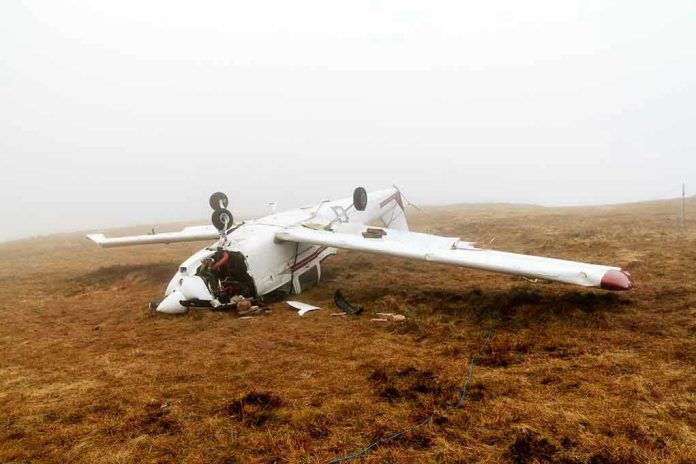
A cutting-edge Air Force special ops plane—once a humble crop duster—crash-landed outside Oklahoma City, raising urgent questions about the risks and rewards of replacing proven military aircraft with civilian conversions.
Story Snapshot
- A newly delivered OA-1K Skyraider II, a converted crop duster, crash-landed during a training flight near Oklahoma City; both crew members were unharmed.
- The aircraft, part of a cost-conscious push for flexible, low-cost military platforms, suffered a suspected engine failure and struck roadside obstacles before coming to rest in a field.
- The incident highlights concerns over the military’s reliance on civilian-derived technology and the pressure to cut costs at the expense of traditional defense standards.
- Investigators are scrutinizing the program’s safety as the Air Force reassesses its strategy of adapting commercial aircraft for combat operations.
Crash of a Converted Crop Duster: What Happened?
On October 23, 2025, a newly delivered OA-1K Skyraider II, an Air Force special operations aircraft converted from the civilian Air Tractor AT-802 crop duster, crashed in a field near Oklahoma City. The incident took place just minutes after the aircraft departed Will Rogers Air National Guard Base for a routine training flight. As the plane lost speed and altitude, the crew declared a mayday, executed an emergency landing on Sooner Road, and ultimately came to rest after striking a stop sign and a utility pole. Thankfully, both the active-duty airman and the civilian contractor onboard survived without injury, and a small grass fire sparked by downed power lines was quickly extinguished by local firefighters.
Origins of the OA-1K: A Cost-Driven Shift in Defense Strategy
The OA-1K Skyraider II is emblematic of the Air Force’s recent push to develop low-cost, easily maintainable platforms for special operations. Derived from the AT-802 agricultural aircraft, the OA-1K was introduced as a solution for missions demanding flexibility, ruggedness, and affordability—qualities that traditional, more expensive military aircraft sometimes lack. The program, awarded to defense contractor L3Harris, reflects a broader trend of adapting civilian technology to meet modern warfare needs, especially for operations in austere or contested environments. This marks a significant departure from decades of investing in purpose-built, high-cost military hardware, a shift driven largely by budget constraints and the perceived need for rapid fielding of new capabilities.
Safety, Survivability, and the Civilian Conversion Debate
While the OA-1K’s robust crop duster design likely contributed to the crew’s survival in this crash, the incident has reignited debate over the risks of using civilian airframes for military roles. Critics argue that, in the rush to cut costs, the Air Force may be compromising on proven standards of survivability and reliability, especially under combat conditions. The crash comes amid ongoing scrutiny of the program, as the OA-1K fleet is among the first of its kind to enter active service. Investigators are now focusing on whether systemic issues with the aircraft or its conversion process may have contributed to the engine failure. The potential for future incidents raises concerns about grounding the fleet and delaying the broader adoption of similar platforms.
Broader Implications: Defense Policy, Community Impact, and Industry Consequences
This crash underscores the tension between fiscal responsibility and military readiness—a debate that has intensified in recent years as policymakers reevaluate defense spending priorities. For conservative Americans who value strong national defense, limited government, and prudent fiscal management, the incident serves as a cautionary tale about the risks of prioritizing short-term savings over long-term reliability. Local communities near Oklahoma City experienced only minor disruption, but the economic and political ramifications could extend much further if program delays or costly modifications are required. As military and industry leaders await the investigation’s outcome, the future of civilian-derived military platforms hangs in the balance, with broader impacts likely for both U.S. defense strategy and the private sector’s role in national security.
Expert Perspectives: Balancing Innovation and Tradition
Aviation analysts point to the OA-1K’s rugged agricultural origins as a reason for its resilience, but they also stress the need for rigorous testing and adaptation when converting commercial designs for military use. While some experts highlight the aircraft’s low operating costs and rapid deployability, others caution that incidents like this one reveal vulnerabilities that could undermine mission success and troop safety. The consensus among credible defense commentators is clear: innovation must not come at the expense of reliability or the core values underpinning American military strength. Ongoing debate will shape whether the Pentagon continues this experiment with civilian conversions or returns to investing in traditional, battle-tested platforms.
Sources:
Air Force crop duster warplane crash lands in Oklahoma
Air Force’s crop duster converted into attack plane crash lands in field
Oklahoma crash: crop duster converted special ops aircraft
OA-1K crash lands Oklahoma crew safe







